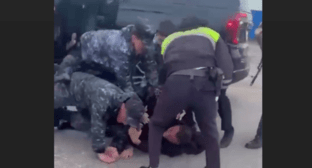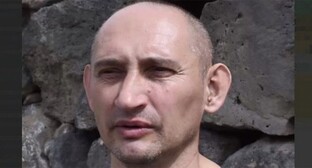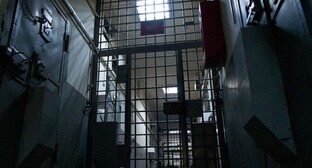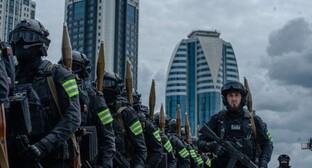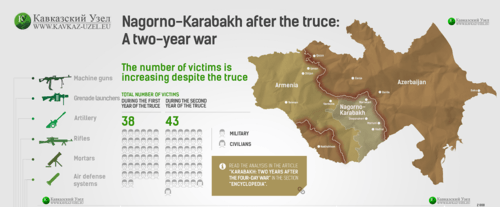
30 October 2019, 17:17
Karabakh: two years after "four-day war"
Two years have passed since the events of the "four-day war," which ended in April 2016 with the conclusion of a truce agreement between the parties to the conflict: Nagorno-Karabakh and Armenia, on the one hand, and Azerbaijan, on the other hand. The formal truce did not stop the confrontation. Until now, the shooting from various types of weapons has not been stopped on the demarcation line, and military personnel and civilians fell victim to shelling attacks. The parties to the conflict continue to accuse each other of violating the ceasefire and using mortar and grenade launchers, large-calibre machine guns, artillery, and sniper rifles.
At night on April 2, 2016, a period of intense confrontation called the "four-day war" began in the Karabakh conflict zone. It lasted until noon on April 5, 2016. Throughout the next year after the aggravation of the situation, shelling attacks in the Karabakh conflict zone did not stop for a single day, despite the truce announced. Following the results of the first year of the truce agreement, the "Caucasian Knot" released the infographics "Karabakh after the truce: 365 days of the war."
In the period from March 31, 2017, to April 1, 2018, judging by the own data of the parties to the conflict, 41 soldiers were killed on both sides, including only five in Azerbaijan. Meanwhile, the Azerbaijani side is responsible for the deaths of two civilians who were killed in early July 2017 by mortar and grenade fire. Another woman then got shrapnel wounds.
In comparison with the data for the first year after the truce agreement, in the period from March 31, 2017, to April 1, 2018, the death toll in the Karabakh conflict zone increased by 13.1%. While the first year of the truce, 38 people were killed, then in the second year of the truce 43 people, including 41 soldiers and two civilians.
It should be noted that the "Caucasian Knot" considers wounded civilians and soldiers as victims of the conflict. The number of wounded military personnel of the Nagorno-Karabakh Defence Army is known: eight military in the first year of the truce and five in the second year. Meanwhile, there are no data about the number of wounded Azerbaijani soldiers, since the Ministry of Defence of Azerbaijan does not provide such information.
According to the Ministries of Defence (MoDs) of Azerbaijan and Nagorno-Karabakh, in the period from March 31, 2017, to April 1, 2018, shelling attacks on the demarcation line did not stop for a single day. However, the data of the MoDs of Nagorno-Karabakh and Azerbaijan show different dynamics. The results of the second year after the truce agreement (supplement by the "Caucasian Knot" as at 5:30 p.m. Moscow time on July 15, 2019: in the infographics, the results of the second year of the truce are given in comparison with the first year) are summarized by the "Caucasian Knot" in the infographics "Karabakh after the truce: A two-year war".
According to the Nagorno-Karabakh's MoD, in the spring of 2017, there was a clear tendency to an increase in the number of shelling attacks from the Azerbaijani side. While in April 2017, the number of shelling attacks per week was 250-300, then in May 2017, their number increased sharply to 400-800, and in the period from May 24 to May 28, the number of shelling attacks reached 850. During the summer-winter in 2017 and 2018, the situation as a whole levelled off: the number of shelling attacks per week was 100–300 with rare increases up to 400 (on June 18-24) and 500 (on July 9-15).
On the other hand, according to the Azerbaijani MoD, the fire coming from the positions of Armenia and Nagorno-Karabakh practically did not weaken for the entire period from March 27, 2017, to April 1, 2018, and there were usually about 800-900 shelling attacks per week. Only in March 2018, the number of shelling attacks decreased slightly, to 680-700 incidents per week.
Judging by the reports of the parties to the conflict, during shelling attacks, Nagorno-Karabakh, Armenia, and Azerbaijan used sniper rifles, 60-mm, 82-mm, and 120-mm mortar launchers, RPG-7 and AGS-17 grenade launchers, large-calibre machine guns, and artillery. Both parties to the conflict continued to use drones.
For the indicated period, the MoDs of Nagorno-Karabakh and Azerbaijan accused each other of three acts of sabotage.
This article was originally published on the Russian page of 24/7 Internet agency ‘Caucasian Knot’ on April 2, 2018 at 01:51 pm MSK.
